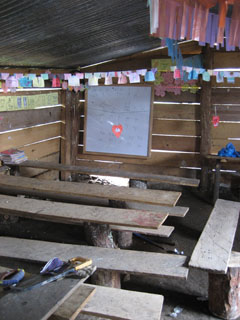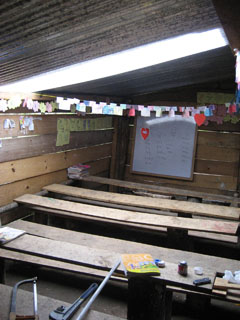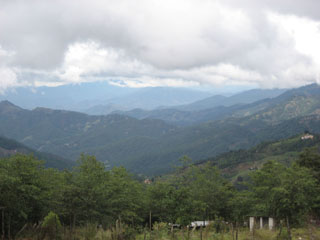
Fletch has touched on a lot of things in his posts, like FBT, or Field Based Training. Right now more than ever, although we’re here together, we spend more time apart, so our perspective on things is a bit different. FBT worked such that all 16 of us who went drew numbers from a hat to be randomly assigned to building teams of four. As luck would have it we weren’t on the same team, which was a little disappointing at first, but we weren’t too sad because we did get to share a hotsel room for a whole week and hang out after work! woohoo! Also, I’ve done a lot of building projects in the last few years and not a single one without Fletch until this moment, so it was a good opportunity to realize how much I knew.I was on a great team with 3 others, another married couple, Katie (who lives in my town) and Joe (who lives in Fletch’s town), and a guy from my town, Aaron, who is pretty much always energetic and in good spirits. We worked at this tiny school in Chocruz, Quiche for the week. The view was amazing, but the school was definitely in poor shape. Jobs included: installing a water catchment system and pila—a popular three basin sink that is used for everything from body, to dish, to clothes washing—so the kids could wash their hands after using the latrines and before eating; building an improved stove for the woman who comes and makes atol for the kids’ mid-day snack; constructing a protective wall around the town’s newly dug well; and replacing part of the classroom roofing with clear laminant to let more light in.
When we arrived at the school it was cold, and pouring rain. I looked at the two buildings facing one another, a total of 3 classrooms, and thought, “Pioneer children went to better schools than this.” I’m not kidding. Quiche is cold and rainy in the winter and the walls of the school house were wood slats with gaping cracks between each one. At least the poineers fitted the logs together and filled the gaps. Even better, there was wood smoke billowing out of the cracks because the teachers light fires on the school room floor to warm the kids snacks and generate a little heat. Can we say chronic respiratory infections? The four of us stood there surveying the area, and I thought, “It’s freezing, it’s raining, and they want us to dig a hole and pour cement here. This week is going to suck.”
But as we looked around and all the scurrying noises registered we realized that the cracks in the school house walls were filled, literally, from floor to ceiling with random pairs of hands and eyes, like hundreds of peeking spiders. Then came the chorus of “Holas!” Our trainer led us into the school house to show us were the water tank needed to be placed. The kids just stared, wide eyed. I think we did a little of the same.
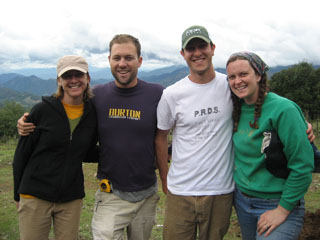
Their seats were stumps of logs and their “tables” were slabs similar to those that made up the walls supported by slightly taller tree stumps. Each classroom was equipped with one sixty watt bulb. The roof was corrugated tin, and there were no windows. We said hello to them. The brave ones started asking us our names and some wanted to shake our hands. We presented ourselves to the school teachers, and when the kids heard our names, they formed a habit that continued for the entire week. One of them would randomly shout out a weird gringo name and see which one of us responded, then everyone laughed. Then they’d shout out another one, or the same one again, then a different one, then the next name, then they’d repeat two of them. We kept turning around and saying hello. This amused them to no end.
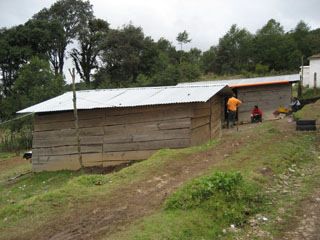
The first day of work was painfully slow, but the kids were warming up to us. Katy and I spent the morning building a table to put the water tank on, inside of the school house. We couldn’t do a lot until the kids were gone. When they told us before we got to our site that we were going to have to remove a wall to install the water tank we thought it was going to be loads of work. Turns out that was incredibly easy, since the wall was just a few boards tacked up with a couple of nails.
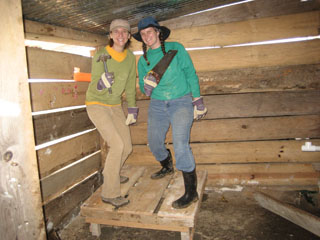
Something we spent an inordinate amount of time doing throughout the week was dropping a single bucket down the new well and hauling it back up. Can I just tell you that a bucket full of water, 20 meters down, weighs a friggin’ ton? I felt like I was building some pretty hot arm muscles. Katie and I had to switch off every three buckets for the burning in our arms. Other than the rain, which stopped pouring about 3 hours into the day, the well was their only source of water. The men had spent 10 days in a row digging through all hours of daylight to reach water. We needed the water to make cement, to show the kids how to properly wash their hands, and to give to the woman who made the atol. We needed it for everything, just like you all need it for everything at home, only here, it’s a much more scarce and a lot more work to obtain. And those of you on boil order for floods, just think of it as sharing a little bit of our experience with us–that’s standard procedure here for any hygenic household.
After the first day, loads of fathers showed up to learn how everything went together and help with the work. We also had the support of a current volunteer and a local albañil, or handy man/carpenter/brick layer. Everything moved along pretty smoothly. The well wall of adobe bricks went up without a hitch and we frosted it with cement like a big cake. The fathers, at one point, looked at Katy and I and said, “You American women are muy trabajadoras,”(hard working).
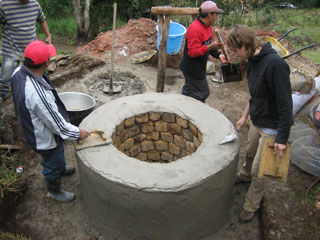
Katy mumbled to me in English, “Look at your own damn wives! We don’t work nearly as hard as they do.” Unlike the women passing by the school every day neither one of us is yet capable of hauling tubs full of cornmeal for tortillas, baskets of laundry, or loads of firewood on our head with a kid strapped to our backs. Can I get a “Thank God!”? The kids also started to talk to us more and more, especially since their dads were there working with us. They started teaching us words in Quiche, so we could at least say good morning to them in their own language, “Zacarric!” They hollered to us through the school house walls the entire time we were working. At one point I was mixing cement for the stove and a ways behind me I heard a girl yell, “EMILY, EMILY! WHAT ARE YOU DOING?” I hollered back that I was mixing cement and she yelled, “I WANT TO HELP YOU!” I told her she could come help when school was out. “OK!” This was my favorite child of the week, Wendy. The day before she’d run out of class and grabbed a shovel to help Katy with a some digging, her hair flying. She seemed to be the leader of her own little independent gang of girls, and her darling little sister, Ingrid, was the half-height always following the older girls around. While most of the kids seemed to like us, there was a faction that always stood off in the distance watching us warily. Thursday when we’d nearly completed everything the kids spent their recess with us. Wendy was there with her gang teaching us how to say cow, house, field, corn—all sorts of random vocabulary because they loved hearing us try to pronounce it and all the little girls had a big crush on Aaron. He asked them if he could take their picture with us. So we all started posing for pictures, when the stand-offish gang come up yelling from across the road. It was a heated debate in Quiche, and Wendy yelled back at them until they walked off.
There’s this pretty persistant rumor going around about gringos being baby stealers, or worse that they steal them to sell their organs on the black market. It didn’t come from nothing. There are people taking children away from mostly young, uneducated, indigenous women for a little bit of money, or none at all, under duress. Less than a year ago there was a ring of illegal adoption agencies uncovered here—around 200 children 2 weeks to 3 years old were found without proper paperwork. The ambassador came to talk to our training group and confirmed that US adoption of Guatemalan babies is one of their biggest jobs, as they have to try and make sure it’s not pure baby selling before they can give the infants US citizenship. And currently 1% of all children born in Gautemala are adopted by American parents. So I wondered to myself what they were yelling, and when the stand offish girls left I asked Wendy what they’d said. She looked at me mostly unconcerned, just a little unsure, “They said kids who get their picture taken die.” The rumor is that the pictures are taken to the US, and then someone comes back to get the children they picked out. It’s pretty disturbing.
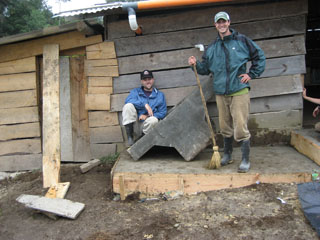 “Hmm. Do you know what we really do with those pictures?” She shook her head. “We send them home to our moms and dads. Since we’re really far away they just want to see what we’re doing and who we’re making friends with. They like to know people are being nice to us and that we’re happy.” She smiled, pretty satisfied to know she didn’t have to believe those other girls, then took off for home.
“Hmm. Do you know what we really do with those pictures?” She shook her head. “We send them home to our moms and dads. Since we’re really far away they just want to see what we’re doing and who we’re making friends with. They like to know people are being nice to us and that we’re happy.” She smiled, pretty satisfied to know she didn’t have to believe those other girls, then took off for home.
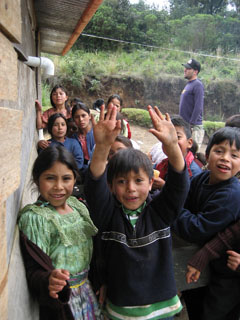 Once all the work was officially we done early Friday morning we did some reinforcement lessons on the higiene we taught earlier in the week, then we taught them how to make tire gardens out of used tires. Unfortunately it didn’t rain from Wednesday afternoon on, so although we had the tank and roof tubing all hooked up, there was no water. And since we were making tire gardens the kids were playing in the dirt, a good time to teach them another instance in which they should wash their hands. So again, we were at the well a good 30 minutes hauling up enough water so that all of them could wash their hands before going home.
Once all the work was officially we done early Friday morning we did some reinforcement lessons on the higiene we taught earlier in the week, then we taught them how to make tire gardens out of used tires. Unfortunately it didn’t rain from Wednesday afternoon on, so although we had the tank and roof tubing all hooked up, there was no water. And since we were making tire gardens the kids were playing in the dirt, a good time to teach them another instance in which they should wash their hands. So again, we were at the well a good 30 minutes hauling up enough water so that all of them could wash their hands before going home.
We left them with a new water system, better lit classrooms, a new stove, and a protected well wall that their fathers all knew how to reproduce and maintain. All of the water system is easily disassembled to put in a new school when they get around to building one. We were all a little sad to 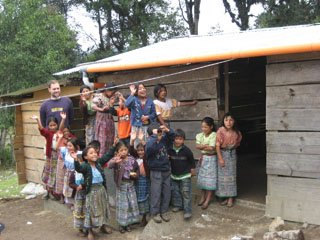 leave the kids. As much as we gave them on the outside of the school, the quality of education here is pretty abismal, and there was nothing we could do in a week to help that. As we were leaving we berated the teachers’ apathy and wondered if they would even keep soap around or bother to put the faucets in place every morning—they were removeable so they could be put inside every night, rather than be stolen. People here who benefit from trainees often benefit the least because they don’t always get the follow up that is necessary for truly sustainable development projects. There is a current volunteer who helped out at Fletch’s school and he is supposed to go back for follow up lessons and reminders for the students, teachers, and parents, but nothing is guaranteed here. In all there were good and bad aspects of the training that were all important in giving us a better idea of how we should work once we’re in our permanent assignment. And even then, it’s still kind of a crapshoot.
leave the kids. As much as we gave them on the outside of the school, the quality of education here is pretty abismal, and there was nothing we could do in a week to help that. As we were leaving we berated the teachers’ apathy and wondered if they would even keep soap around or bother to put the faucets in place every morning—they were removeable so they could be put inside every night, rather than be stolen. People here who benefit from trainees often benefit the least because they don’t always get the follow up that is necessary for truly sustainable development projects. There is a current volunteer who helped out at Fletch’s school and he is supposed to go back for follow up lessons and reminders for the students, teachers, and parents, but nothing is guaranteed here. In all there were good and bad aspects of the training that were all important in giving us a better idea of how we should work once we’re in our permanent assignment. And even then, it’s still kind of a crapshoot.
